We explain what ancient Egypt was, its religion and architecture. In addition, we explore its characteristics and discoveries.

What is Ancient Egypt?
Ancient Egypt was a civilization of the ancient world that flourished between 3300 BC and 332 BC in the Nile Valley in North Africa. The abundance of its natural resources and its geographical isolation contributed to its success and power.
Throughout its long history, it upheld a cultural tradition that gave it unity during times of political and social crises. In periods of state prosperity, the kingdom of Egypt was unified under the rule of pharaohs whose power was legitimized through religious beliefs.
Priests adorned their temples with artistic representations and hieroglyphic writing that specialists were only able to decipher in the 19th century. The great pyramids, the tombs filled with rich treasures, and the beautiful temples of Egyptian cities have marveled other populations throughout history.
- See also: Roman Empire
Characteristics of Ancient Egyptian civilization
The main characteristics of ancient Egyptian civilization were:
- They inhabited the Nile Valleys in North Africa between 3300 and 332 BC.
- They had a long history marked by periods of unification and fragmentation of the kingdom of Egypt.
- The state was organized around the figure of the pharaoh, an absolute ruler legitimized by religious beliefs.
- Their economic organization was controlled by the state, through a system of taxation and redistribution of goods and services.
- They established a polytheistic religion, whose main gods were Osiris, Isis, Horus, and Seth.
- They had a hierarchical society with privileged classes living off the tribute paid by the majority of the population.
- They developed a complex writing system that evolved over time.
Geographic location of Ancient Egypt

Ancient Egyptian civilization settled in the Nile Valley in North Africa. The Nile rises in Lake Victoria, flows northward, and empties into the Mediterranean Sea, forming a delta. Along its course, the Nile has six cataracts. The region between the first cataract and the delta is called Upper Egypt, while the delta region is known as Lower Egypt.
The Nile Valley is a very fertile region in the middle of the desert, which is fed by the swelling of the river in spring. The Egyptians called this land Kemet, which meant "black fertile land".
History of Ancient Egypt

The exact origin of the Egyptian people remains unknown. Specialists believe that they likely originated in the Arabian Peninsula and settled in the Nile Valley. Initially, the Egyptians organized themselves into clan families known as "nomes". Over time, these nomes grew and unified their power to form two great kingdoms: one in Upper Egypt and another in Lower Egypt.
Scholars divide the history of ancient Egypt into major periods, in which Upper Egypt and Lower Egypt were either unified or separated into several independent kingdoms:
- Archaic Period (3300-2800 BC). Upper Egypt triumphed over Lower Egypt under the leadership of King Scorpion (a legendary figure of whom archaeologists know little). King Narmer proclaimed himself pharaoh of unified Egypt and established the capital in the city of Thinis, from where the first two dynasties of pharaohs ruled.
- Old Kingdom (2800-2100 BC). The third dynasty moved the capital to the city of Memphis, and undertook significant constructions throughout the kingdom. During this period, different dynasties expanded the kingdom, incorporating new territories through conquests and trade. Pharaohs Khufu, Khafre, and Menkaure built the great pyramids of Giza. The newly annexed territories were ruled by viziers under the pharaoh's orders. By 2300 BC, the viziers consolidated power in their respective territories, and Egypt lost its unity.
- Middle Kingdom (2100-1580 BC). The princes of Upper Egypt reunified the territory and established their capital at Thebes. However, disputes flared between the north and the south over the government, and desert peoples invaded various parts of the kingdom. This crisis fragmented the empire into different realms, and Egypt again lost its unity.
- New Kingdom (1580-1100 BC). The princes of Thebes succeeded in defeating the peoples of the Libyan desert, and reunified Egypt. Pharaohs Amenhotep II and Ramses II resumed territorial expansion, conquering parts of Asia.
- Late Period of Sais (1100-332 BC). New conflicts between the upper classes of military chiefs and priests led to a political crisis, worsened by the Assyrian invasion. Around the 7th century BC, Pharaoh Psamtik I succeeded in centralizing power again, establishing the capital at Sais, a city in the delta. Later, the Persians invaded the kingdom, and the pharaohs had to rely on alliances with foreign kingdoms to maintain their independence. In 332 BC, Alexander the Great, king of Macedonia, invaded Egypt, which never regained its independence.
Political organization of Ancient Egypt
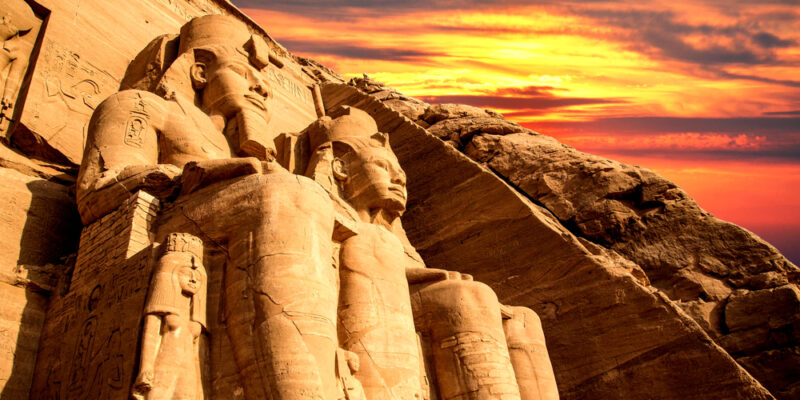
Throughout its history, the political organization of ancient Egypt changed. In the periods when Egypt was unified as a great kingdom, political power was held by a pharaoh, who controlled all aspects of the kingdom's administration.
Dynasties were formed (families of rulers who inherited the pharaoh's crown), which legitimized their power theocratically. The Egyptians considered the pharaoh an intermediary between the gods and the people. His power had been bestowed by the gods, and he was honored in a religious and ceremonial manner.
The pharaoh was surrounded by a court that consisted of his family and his personal advisors. The kingdom appointed various officials for its administration, and the nomes (provinces within the kingdom) were governed by viziers under the pharaoh's command.
In order to maintain their power, pharaohs had an army composed mostly of mercenary troops (foreign professional soldiers paid a wage). In this way, the pharaoh kept the Egyptian population disarmed and engaged in productive tasks.
Social structure in Ancient Egypt
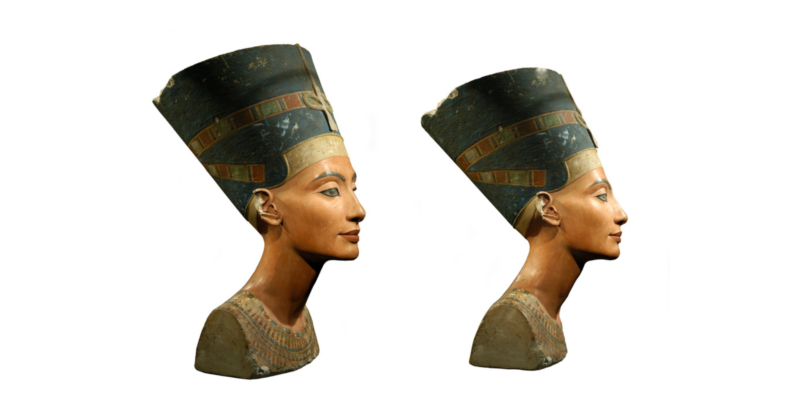
Throughout its history, the Egyptian people were governed by a dominant social class that lived off tributes paid by the rest of the population. This class included the pharaoh and his family, court members, noble families, the groups of priests, and administrative officials with varying levels of power according to their functions.
The Egyptian state maintained certain officials due to the importance of their roles in the kingdom's administration. For example, scribes were people who could read, write, and count. They worked in palaces and temples, and were responsible for recording tax collection and administering the government's wealth
The majority of the population engaged in agriculture, cultivating small to medium-sized plots of land. Peasants had to give a portion of their produce to the pharaoh, noble families, or priests, who owned all the lands in Egypt.
In addition, in the cities there were craftsmen and people engaged in various professions: builders, weavers, merchants, potters, etc. Some tasks were considered more respectable than others. For instance, sculptors who made statues decorating temples and palaces were better accepted socially. In contrast, embalmers (people dedicated to the mummification of bodies) had to live in distant neighborhoods as they were deemed impure.
Egyptian society had certain egalitarian features in terms of gender. Men could only marry one woman, unlike in other ancient societies. Marriage was not executed by purchasing a spouse, but by a mutually agreed religious ritual. In addition, women could hold political positions, and at different points in history, female pharaohs ruled Egypt.
Ancient Egyptian economy
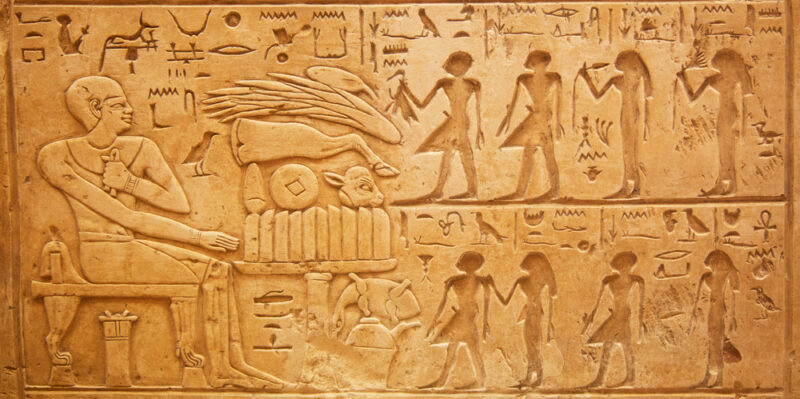
Throughout its history, the economy in ancient Egypt was controlled by the state. As the basis of production was agricultural and depended on the Nile River, the state needed to distribute water through canals, and control productive resources.
The pharaoh owned all the land and delegated it to priests and government officials. These, in turn, designated it to the peasants to work it in exchange for the payment of a tribute. Agricultural production was based on wheat, barley, fruits and vegetables. In addition, they used papyrus to make paper, and extracted gold, copper, amethyst, and turquoise from mountain ranges.
The Egyptian state developed a redistribution system of goods around royal palaces and temples, where officials and priests stored the various goods and products obtained through the collection of tributes from peasants and craftsmen. A portion of these goods was destined for all state administration members who depended on the government: the pharaoh, the court, priests, officials, soldiers, etc. Another portion was used for the construction of public works. Other goods and products were stored in case of crisis and need: they were redistributed among city inhabitants during food shortages.
Trade in ancient Egyptian economy was mainly internal. Regional rulers exchanged luxury products collected as tribute: textiles, jewelry, ceramics, animals, and slaves. Foreign trade was limited as Egypt was surrounded by deserts, mountain ranges, and the Mediterranean Sea, which was not used for navigation. Over time, they developed trade routes crossing the desert to the east, reaching the cities of Asian Mesopotamia, and to the west, reaching Carthage.
Ancient Egyptian religion

Egyptian religion was polytheistic, that is, they worshiped many gods. It was formed as a result of various local cults of the peoples inhabiting the entire Nile Valley. These beliefs were centered on the existence of deities associated with different natural phenomena, celestial bodies, and animals. Deities were often represented with human forms or a combination of human and animal traits. With the unification of the Egyptian kingdom, priests created a unified pantheon.
Osiris myth
Osiris myth recounted that Osiris (sun god and creator) was married to Isis (goddess of fertility and magic), who together conceived Horus (sky god, protector of Egyptian royalty). Seth (god of deserts, brother of Osiris) murdered Osiris and usurped the Egyptian throne. When Isis was mourning her husband's death, her tears caused the first overflow of the Nile River. She then decided to mummify Osiris's body.
Isis was aided by Anubis (god of death) and Thoth (god of wisdom). Subsequently, Osiris was resurrected, ruling the realm of the dead. To avenge his father, Horus confronted Seth and reclaimed the Egyptian throne. The eternal struggle between Seth and Horus symbolized for the Egyptians the daily battle between light and darkness, which repeated daily with the day-night cycle.
Worship of Amun and Aten
Throughout its history, Egyptian religion was influenced by political events. The political preeminence of priests from major cities intensified the worship of patron gods from those cities.
For instance, around 1500 BC, Pharaoh Hatshepsut ruled with the aid of the Theban priests, who worshiped god Amun. Later, Pharaoh Akhenaten (Amenophis IV) sought to break free from these priests' influence. He established Aten as the sole god, discarded the worship of other gods, and persecuted the priests and followers of god Amun. However, years later, his son Tutankhamun reinstated the worship of Amun, and over time, the polytheistic religion resumed openly.
Cult of the dead
Egyptians believed that a person was made up of three elements: body, soul, and ka. The ka was a vital force that gave people identity, directed and protected them. Upon death, the ka departed the mouth and embarked on a journey to Osiris's tribunal, before which one's deeds were judged. God Anubis placed the heart of the deceased on a weighing scale against a feather, weighing past actions. If the scale remained in balance, the ka could either live with Osiris or return to its tomb. Otherwise, it was devoured by Ammit, a beast that would make it disappear forever.
For the ka's journey, Egyptians practiced various funerary rites. The mummification of the corpse preserved the body for the ka, should it wish to return to the tomb. Sarcophagi contained items left to guide the ka on its journey (such as the scroll of the Book of the Dead, providing moral teachings on how to find its way to Osiris). Additionally, a ritual was practiced in which a priest wore a mask of Anubis, restoring the ka's senses it had had in life: sight, taste, hearing, and smell.
Ancient Egyptian culture
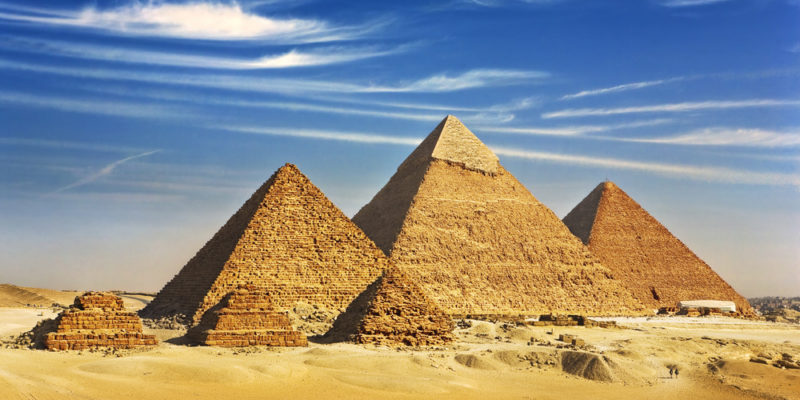
Key cultural elements of the Egyptian civilization included:
Egyptian architecture
The pyramids constitute one of the most significant icons of Egyptian architecture. These majestic stone structures served as tombs, aiding the pharaoh's soul in its journey to the afterlife. They had a complex system of corridors and chambers. In the main chamber, the most difficult to access, the mummified body was placed along with numerous belongings, food, drink and valuable objects that could be of use to the soul in the afterlife.
The Great Pyramid of Giza was commissioned by Pharaoh Khufu, also known as Cheops, around 2570 BC, its base measuring 440 cubits x 440 cubits, equivalent to 754 feet x 754 feet (230.56 meters x 230.56 meters). It is estimated that construction took 20 years, requiring the work of about 10,000 men. It remains the oldest of the seven wonders of the ancient world.
Most of the pyramids have been looted throughout history due to the amount of valuable objects they contained. However, hieroglyphic inscriptions that abound on these temple walls have provided archaeologists with astonishing details.
Egyptian writing
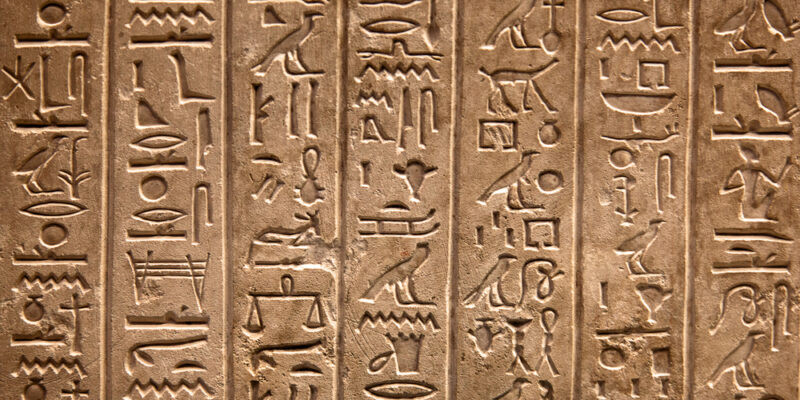
Ancient Egyptians developed a hieroglyphic writing system. Through symbols termed hieroglyphs, they represented ideas and concepts. The oldest hieroglyphs were ideographic. Each sign represented the object it illustrated, and had to be read in the context it was used. For instance, a human figure could mean "man" or "power".
Developed around 3200 BC, this system evolved, becoming more complex. Symbols started to have phonetic value: each one represented a sound and several were combined to form a word. The same sign could have an ideographic, phonetic, or combined meaning. As it was an intricate system, only priests trained in hieroglyphic writing used it. They recorded Egyptian beliefs and rites on temple walls, tombs, monuments, and palaces.
Over time, a simpler writing system known as hieratic was developed for writing on papyri. Palace and temple scribes used it for writing administrative texts and recording resources. It was also used by priests and sages who advanced scientific and religious knowledge. In the last period of Egyptian history, an even simpler writing system known as demotic was created.
Egyptian numeration system
Because of their advanced knowledge of mathematics and measurement, the Egyptians excelled in numbers and calculations like no other civilization. They introduced a unit of measurement called the "cubit", which was calculated by measuring the length of the forearm (from the elbow to the fingertips).
They later developed the "royal cubit", which was equivalent to 1 ft 5 ½ in (0.524 meters) in length and was subdivided into 7 sections of 4 fingers each (with a total of 28 fingers per unit of measurement).
Ancient Egyptian medicine
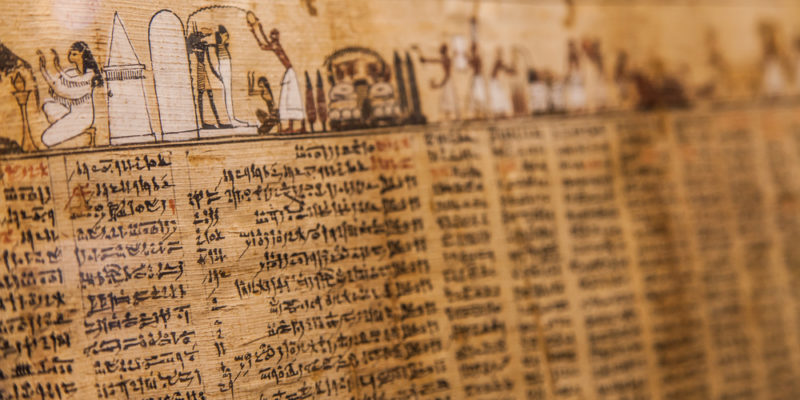
Religious beliefs about death and resurrection, combined with knowledge of anatomy and chemistry, contributed to ancient Egyptian civilization success in the field of health.
Egyptians saw diseases as punishments from gods, or as evil spirits inside the body that had to be expelled through rituals or incantations.
As a result of the mummification tradition, they developed skills to recognize the different parts of the body and associate them with certain diseases. They identified as many as 28 lesions types, and even performed surgeries, evidence of which was found in mummies (such as cranial trepanation or tumor removal).
Explore next:
References
- Grimal, N. (2004). Historia del antiguo Egipto (Vol. 184). Ediciones AKAL.
- Stead, I. M., & Stead, M. (1998). La vida en el antiguo Egipto (Vol. 1). Ediciones AKAL.
- Trigger, B. G., Kemp, B. J., O'Connor, D., & Lloyd, A. B. (1983). Ancient Egypt: a social history. Cambridge University Press.
- “Ancient Egypt”. Natonal Geographic.
- “Ancient Egypt”. Encyclopaedia Britannica.
- “Ancient egyptian beliefs”. Dallas Museum of Art.
- “Las prácticas médicas del antiguo Egipto que aún se utilizan”. BBC.
Was this information useful to you?
Yes NoThank you for visiting us :)